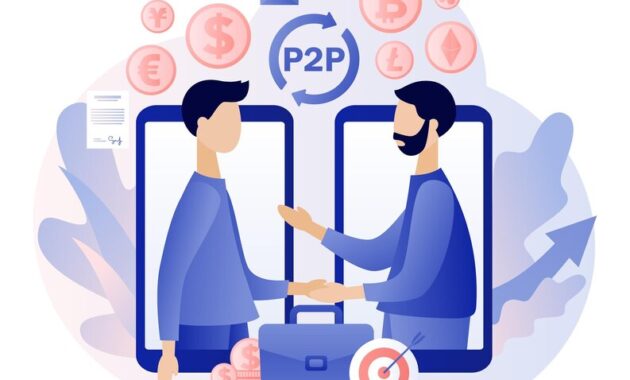Peer-to-peer (P2P) lending represents a financial revolution transforming how individuals and small businesses access loans and investors seek returns. In this digital age, P2P lending platforms serve as intermediaries, connecting borrowers directly with investors online.
This article explores the dynamics of P2P lending, shedding light on its operation, advantages, and potential risks. As financial technology (FinTech) continues to reshape traditional banking, understanding P2P lending is essential for those looking to diversify their investment portfolios and explore innovative opportunities in the ever-evolving landscape of modern finance.
Understanding Peer-to-Peer Lending
Peer-to-peer lending, often called P2P lending, is a financial innovation that has reshaped how individuals and businesses access loans and investors earn returns. It involves connecting borrowers directly with individual investors through online platforms. These platforms act as intermediaries, facilitating the lending process. Borrowers create loan listings, and investors can choose to fund them, often in small increments. As borrowers make loan payments, investors receive both the principal and interest, potentially earning higher returns than traditional savings accounts.
The Advantages of Peer-to-Peer Lending
Investing in P2P lending offers several advantages:
- It can provide higher potential returns compared to traditional savings accounts or bonds.
- It offers diversification opportunities, as investors can spread their investments across numerous loans.
- P2P lending platforms have made borrowing more accessible, especially for those who may not qualify for traditional bank loans.
Transparency is a crucial advantage, with detailed loan information available to investors, reducing the need for intermediaries.
Risks and Challenges in P2P Lending
While P2P lending has its merits, it’s not without risks. Default risk is a significant concern, as borrowers may fail to repay loans, resulting in the loss of principal for investors. Unlike banks, P2P platforms may lack regulatory oversight, increasing the potential for fraud or unethical practices. Liquidity concerns also exist, as it may be challenging to sell P2P loans before their term ends. Mitigating these risks involves thorough research, diversification, and careful loan selection.
How to Get Started with P2P Lending
Getting started with Peer-to-Peer (P2P) lending is an exciting venture into FinTech-driven investment. Here’s a step-by-step guide to help you begin your journey:
- Educate Yourself: Before diving in, take the time to educate yourself about P2P lending. Understand how it operates, the risks involved, and the potential rewards. Read articles, watch videos, and consider joining online forums or communities where P2P investors share their experiences.
- Assess Your Financial Situation: Evaluate your financial goals and risk tolerance. Determine how much you’re comfortable investing in P2P lending. Remember that your investments should align with your overall financial strategy.
- Choose a Reputable P2P Platform: Research and select a trustworthy P2P lending platform. Watch for platforms with a solid track record, clear fee structures, and transparent loan information. Check consumer reviews and ratings to gauge the platform’s reputation.
- Create an Investor Account: Sign up on your chosen P2P lending platform. Provide the required identification and financial information. Platforms often require proof of identity and may conduct credit checks.
- Deposit Funds: Transfer the amount you want to invest into your investor account. Most platforms offer funding options, such as bank transfers or linking a bank account or credit card.
- Explore Loan Listings: Once your account is funded, explore the loan listings available on the platform. These listings provide details about borrowers, including loan purpose, credit score, loan amount, and interest rate. Choose loans that align with your investment objective and danger tolerance.
- Build a Diversified Portfolio: Diversification is a critical strategy in P2P lending. Instead of investing all your funds in a single loan, spread your investment across multiple loans to reduce risk. Select loans with varying risk profiles and terms.
- Monitor Your Investments: After investing, regularly monitor the performance of your loans. Check for any missed payments or defaults and be prepared to take action if necessary. Many P2P platforms provide tools and notifications to help you track your investments.
- Reinvest Earnings: As borrowers make payments, you’ll receive investment returns. Consider reinvesting these earnings into new loans to compound your returns and accelerate the increase of your P2P lending portfolio.
- Stay Informed: The P2P lending landscape is constantly evolving. Stay informed about changes in the industry, updates from your chosen platform, and emerging trends. Being knowledgeable will help you make informed investment decisions.
The Future of P2P Lending
The future of P2P lending looks promising. As technology continues to advance, FinTech innovations are reshaping the financial landscape. Regulatory developments will likely provide investors increased protection and stability in P2P lending. Predictions for the P2P lending landscape include more significant market expansion and diverse lending options. As the industry evolves, staying informed and adapting to changes will be crucial for investors looking to capitalize on this FinTech revolution.
Q&A Section
How can I minimize the risk of loan defaults in P2P lending?
Diversification is key. Spread your investments throughout multiple loans to reduce the impact of any single default. Additionally, thoroughly research borrowers, consider credit scores, and select loans with appropriate risk levels.
What are the typical returns investors can expect from P2P lending?
Returns vary but often range from 4% to 8%. However, depending on the platform, loan types, and individual loan performance, they can be higher or lower.
Are P2P lending platforms regulated, and how can I ensure they are trustworthy?
Regulation varies by country and region. To ensure trustworthiness, research platforms thoroughly, look for user reviews, check if they are licensed, and inquire about their track record and security measures.
Can I sell my P2P loans before they mature?
Liquidity varies by platform. Some P2P lending platforms offer secondary markets where you can sell loans to other investors, but it’s essential to check if this option is available.
Are there tax implications for P2P lending income?
Yes, P2P lending income is generally considered taxable income. Discuss with a tax expert to understand your tax obligations and deductions related to P2P lending.
Conclusion
Peer-to-peer lending has emerged as a groundbreaking investment avenue in the FinTech revolution. Understanding the mechanics of P2P lending, its advantages and risks, and how to get started is essential for anyone looking to participate in this innovative financial ecosystem. As technology and regulations continue to shape the industry, the future of P2P lending promises exciting possibilities for both borrowers and investors. Exploring P2P lending can be rewarding to diversify your investment portfolio and earn attractive returns in today’s evolving financial landscape.


